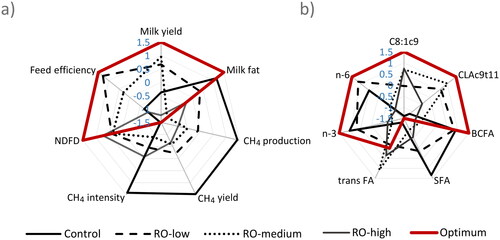Figures & data
Table 1. Ingredients and chemical composition of the four experimental grass silage-based diets fed to dairy cows.
Table 2. Nutrient intakes and milk performances in dairy cows fed iso-energetic diets based on grass silage and characterised by different contents of rapeseed oil and starch.
Table 3. Methane and carbon dioxide emissions in dairy cows fed iso-energetic diets based on grass silage and characterised by different contents of rapeseed oil and starch.
Table 4. Total tract digestibility of nutrients and rumen parameters before feeding in dairy cows fed iso-energetic diets based on grass silage and characterised by different contents of rapeseed oil and starch.
Table 5. Milk fatty acid profile in dairy cows fed iso-energetic diets based on grass silage and characterised by different contents of rapeseed oil and starch.
Figure 1. Spider plots of the normalised (Z score) variables1 describing (a) dairy performance and digestion parameters including eCH4 and (b) milk fatty acid (FA) composition according to the nature of energy (rapeseed oil vs. starch) in the four iso-energetic and grass silage-based diets of dairy cows (Control, RO-low, RO-medium, RO-high). The optimum shape is represented by the red line: positive variables for the dairy performance or healthy milk FA for human nutrition were expected to have the maximum Z score, whereas the minimum Z score was desired for eCH4 or non-healthy milk FA (SFA); Z score scale from -1.5 to 1.0 with Z = 0 for the overall average of the four diets.
1Fatty acids, g/100g FA; Feed efficiency, kg milk/kg DMI; Milk yield, kg/d; Milk fat, g/kg; daily eCH4, g/d; eCH4 yield, g/kg DMI; eCH4 intensity, g/kg milk; NDFD, NDF digestibility, %; BCFA, branched-chain FA.

Data availability statement
The data that support the findings of this study are available from the corresponding author, CM, upon reasonable request.
